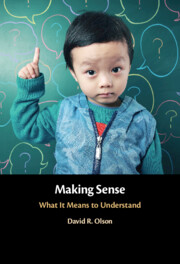Book contents
- Making Sense
- Making Sense
- Copyright page
- Dedication
- Contents
- Figures
- Tables
- Preface
- 1 An Introduction to the Puzzles of Understanding
- 2 Understanding As Feeling and As a Concept
- 3 The Linguistic Basis of Mind
- 4 Subjective Mental States
- 5 Objective Mental States
- 6 Intersubjectivity of Mental States
- 7 Identity Conditions for Feelings and Concepts
- 8 What “Understanding” Means
- 9 The Referential Scope of Understanding
- 10 Understanding and Children’s Theory of Mind
- 11 Understanding and Sense-Making
- 12 Understanding As a Learnable Skill
- 13 Understanding in Everyday Life
- 14 Ascriptivism and Cognitive Development
- References
- Index
12 - Understanding As a Learnable Skill
Published online by Cambridge University Press: 21 April 2022
- Making Sense
- Making Sense
- Copyright page
- Dedication
- Contents
- Figures
- Tables
- Preface
- 1 An Introduction to the Puzzles of Understanding
- 2 Understanding As Feeling and As a Concept
- 3 The Linguistic Basis of Mind
- 4 Subjective Mental States
- 5 Objective Mental States
- 6 Intersubjectivity of Mental States
- 7 Identity Conditions for Feelings and Concepts
- 8 What “Understanding” Means
- 9 The Referential Scope of Understanding
- 10 Understanding and Children’s Theory of Mind
- 11 Understanding and Sense-Making
- 12 Understanding As a Learnable Skill
- 13 Understanding in Everyday Life
- 14 Ascriptivism and Cognitive Development
- References
- Index
Summary
In this chapter, I pick up the theme advanced in Chapter 8 where I distinguished between ascription of understanding to subjects whether by parent, teacher, or scientist, to the ascription of understanding by subjects themselves. We adults ascribe understanding to children when we judge that their behavior meets the criteria for understanding, namely correctness and intersubjectivity. It is we as ascribers who make the judgment. Here I focus on the second part, namely how the children ascribe understanding whether to themselves or to others. That is, I consider the benefits that accrue to the children when they themselves learn to make ascriptions of understanding. I have already hinted at the answer: To ascribe is to judge that an interpretation has met the standards of correctness and intersubjectivity and to justify the ascription by appeal to the evidence that can warrant the judgment.
- Type
- Chapter
- Information
- Making SenseWhat It Means to Understand, pp. 131 - 148Publisher: Cambridge University PressPrint publication year: 2022

